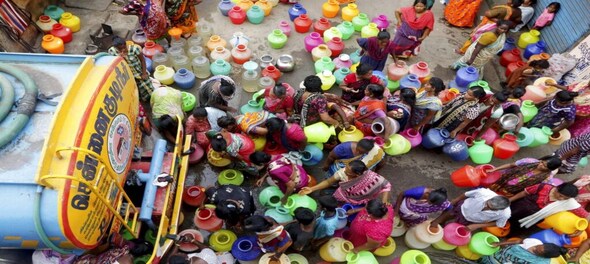
Water supply will be affected in parts of Delhi on Friday evening and Saturday morning. The Delhi Jal Board (BJB) released a statement advising residents to store sufficient quantity of water in advance as per the requirement. "Water tanker will be available on request," it said.
List of areas affected
Defence Colony, Moolchand, Greater Kailash, Delhi Gate, Majnu Ka Tilla and adjoining areas, Tilak Marg and areas under the New Delhi Municipal Council, Hanuman Mandir, Raj Ghat, LNJP Hospita; ITO, Secretariate, NDMC, IP emergency, Tilak Marg, Zoo and adjoining area, CGO Complex, Ramlila Ground, Delhi Gate and adjoining areas.
What's the reason for disruptions in water supply ?
The Delhi Jal Board said due to the replacement of a delivery line at Wazirabad, a 40 MGD (million gallons per day) plant will remain non-operational affecting water supply on Friday evening and Saturday morning.
Besides the repair work, the shortage of water in Yamuna is another reason adding to Delhiites' water woes. During an inspection at the Wazirabad Water Treatment Plant, Delhi Jal Board Vice-Chairman Saurabh Bhardwaj said on March 8 that the water level in Yamuna had witnessed an "unprecedented decrease".
Meanwhile, the Indian Express reported that the water level in the Yamuna at Wazirabad has been below the normal level for around two weeks, affecting the production at the Wazirabad and Chandrawal water treatment plants.
Bhardwaj informed that this time, the water level of Yamuna near Wazirabad Barrage suddenly went down to 671.7 feet in the month of February itself. He told ANI that the normal level of Yamuna River at Wazirabad Barrage should be 674.5 feet.
Also, "the depth of Yamuna should be at least 3.5 feet (presently it's even less than 1 foot) which allows the offtake of raw water from Yamuna for the Water Treatment Plant", he was quoted by ANI as saying.
Why Yamuna water level is depleting?
While reports cite low rainfall in Northwest India and rising temperature as the reasons, Bhardwaj alleged that the key reason for the water level decrease in Yamuna is the "rampant illegal sand mining being done indiscriminately in the Yamuna river in the state of Haryana".
"The sand mafia had stopped the Yamuna water released for Delhi in an area of about 7-8 km from Yamuna Nagar that lies in Haryana, where the sand mafia is indiscriminately mining sand in the Yamuna River," he said.
He added that the Yamuna water, which is presently visible near Wazirabad Barrage, is not the actual Yamuna water but industrial waste which is being released from Haryana.
"The flow that is reaching Delhi is coming from two drains. Industrial waste is constantly being released into Yamuna by Haryana through DD2 and DD8 drains," he said while referring to images from Google Maps and satellite imagery.
"Apart from hazardous chemical elements in this industrial waste, the ammonia level is also way higher than the prescribed limits. The excessive ammonia disallows the visible water to get treated in the Water Treatment Plants. Previously also, Haryana had released industrial waste, but due to the sufficient amount of water in Yamuna, water could be treated," Bhardwaj said.
'What will happen in summers?'
Raising concern over the current situation, a Defence Colony resident was quoted by the Indian Express as saying, "...It’s hard to imagine what it’s going to be like when peak summer comes".
Meanwhile, Deepak Baweja, president of an RWA in New Rajinder Nagar, was quoted as saying that the shortage has been there in the winter as well. He mentioned that the "water treatment centre has not been getting enough water", and thus, informed that he requested the MLA to find a solution.
Solution to Delhi water woes
A DJB spokesperson said daily supply has been reduced to supply every alternate day in some places. To meet the demands, he said, tubewells are being installed to augment supply.
Tubewells that are expected to yield a total of 20.9 MGD are in the process of being installed. Some of them are expected to function by March and May this year. More tubewells — 259 in total with a combined capacity of 42.5 MGD — are also proposed to be set up at Palla, near Bhalswa lake, the Indian Express reported.
The report added that the DJB is in the process of preparing a "summer action plan". Under this plan, the aouthroties will map areas that are vulnerable to shortage. The DJB will then take site-specific measures like deploying tankers and installing tubewells.
First Published: Mar 10, 2023 10:41 AM IST
Check out our in-depth Market Coverage, Business News & get real-time Stock Market Updates on CNBC-TV18. Also, Watch our channels CNBC-TV18, CNBC Awaaz and CNBC Bajar Live on-the-go!


Prajwal Revanna's father in custody for alleged kidnapping and sexual abuse
May 4, 2024 7:53 PM
Delhi, Indore, Surat and Banswara — why these are the most challenging domains for Congress internally
May 4, 2024 1:53 PM
Congress nominee from Puri Lok Sabha seat withdraws, citing no funds from party
May 4, 2024 12:00 PM
Lok Sabha Polls '24 | Rahul Gandhi in Rae Bareli, why not Amethi
May 4, 2024 9:43 AM

